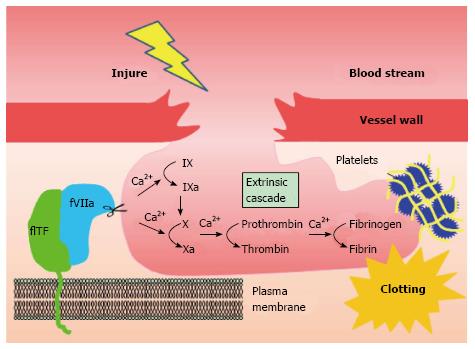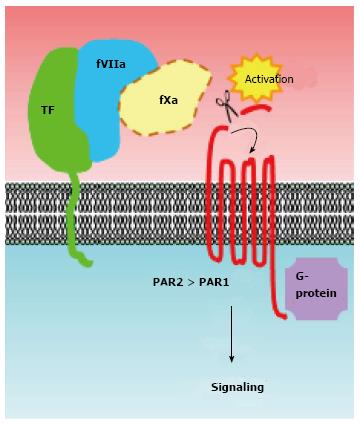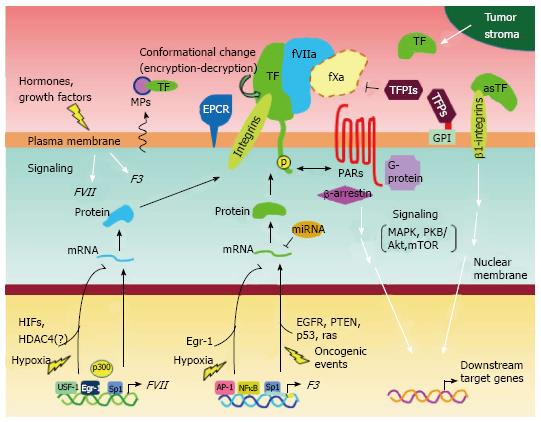Copyright
©2014 Baishideng Publishing Group Inc.
World J Clin Oncol. Dec 10, 2014; 5(5): 908-920
Published online Dec 10, 2014. doi: 10.5306/wjco.v5.i5.908
Published online Dec 10, 2014. doi: 10.5306/wjco.v5.i5.908
Figure 1 Extrinsic coagulation cascade initiated by the tissue factor-coagulation factor VII pathway.
TF-fVIIa complex formation on the plasma membrane triggers an extrinsic coagulation cascade in response to injury. The TF-fVIIa complex located on the cell surface initiates the coagulation cascade by activating factor X via two different (coagulation factor IX-dependent or -independent) routes. This leads to fibrin deposition via the formation of thrombin. Blood coagulation completes by clot formation with other factors, such as platelets and red blood cells. FVII: Coagulation factor VII (fVII); TF: Tissue factor.
Figure 2 Activation of protease-activated receptors is a major mechanism of tissue factor-coagulation factor VIIa signaling in breast cancer cells.
The proteolytic activities of the TF-fVIIa binary complex [potentially (designated as dotted line) ternary complex with fXa] cleave the N-terminal end of PARs. PARs are then activated via intra-molecular binding between the newly created N-terminus and an extracellular loop region of the receptors. Activation of these G-protein-coupled receptors subsequently activates downstream signaling cascades. A number of studies have indicated that PAR2 is crucial for activation of a TF-fVII-driven signaling cascade in breast cancer cells. The role of TF-fVII on PAR1 signaling in breast cancer cells is less evident. FVII: Coagulation factor VII; TF: Tissue factor; PARs: Protease-activated receptors.
Figure 3 Possible mechanisms of expression and functional regulation of tissue factor and coagulation factor VII in breast cancer cells.
Schematic overview summarizing the multiple mechanisms of gene expression, functional tuning, and intracellular signaling in breast cancer cells, as described in this review. It has been suggested that breast cancer cell phenotypes associated with the TF-fVII pathway may be specifically controlled via multiple autocrine and/or paracrine mechanisms, depending on tumor microenvironmental conditions. EGFR: Epidermal growth factor receptor; EPCR: Endothelial protein C receptor; FVII: Coagulation factor VII; TF: Tissue factor.
- Citation: Koizume S, Miyagi Y. Breast cancer phenotypes regulated by tissue factor-factor VII pathway: Possible therapeutic targets. World J Clin Oncol 2014; 5(5): 908-920
- URL: https://www.wjgnet.com/2218-4333/full/v5/i5/908.htm
- DOI: https://dx.doi.org/10.5306/wjco.v5.i5.908











